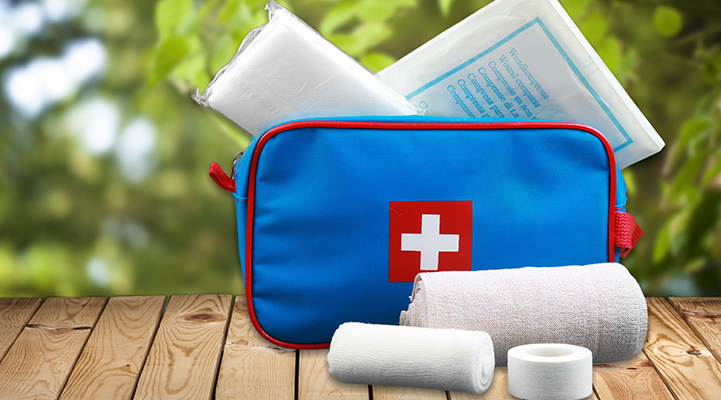
Managing bleeds: an important part of living with VWD
For more information about managing bleeds, visit these websites, or read these publications: the World Federation of Hemophilia website (http://www1.wfh.org/publications/files/pdf-1472.pdf), the National Heart, Lung and Blood Institute website (https://www.nhlbi.nih.gov/health/health-topics/topics/hemophilia/signs), and Rivard G, Blanchette V, Hilliard P, Mulder K, Zourikian N. Management of bleeds. In: Hum D, ed. All About Hemophilia: A Guide for Families. 2nd ed. Montreal, Quebec: Canadian Hemophilia Society; 2010: chap 4.
There are many steps you can take to help prevent bleeds, but no matter how careful you are, you may still experience occasional bleeding. In addition to obvious external bleeding, it's important to be able to quickly recognize and treat an internal bleed to help prevent damage to joints, tissue, and organs.
How will I know if I have an internal bleed?
Joint bleeds
- You may notice an initial unusual feeling in the area of the bleed, sometimes described as a tingling sensation
- There may be swelling or pain surrounding the joint
- The skin covering the area may feel warmer than normal
Brain bleeds
- Your neck may hurt or feel stiff or you may have a painful headache that won't go away
- You may vomit repeatedly and you might experience double vision
- There may be a sudden weakness in your legs or arms
- You may be very sleepy or others might notice a change in your behavior
- Seizures and convulsions are also possible
Other internal bleeds
- Watch for blood in your urine or stool. Blood in your urine may mean you have a kidney or bladder bleed. Blood in your stool might signal an intestinal or stomach bleed
- Internal bleeds may become "visible" externally if blood pools into larger muscles and causes bruising
Go to the emergency room (ER) immediately if you are experiencing any signs of an organ or brain bleed.
When should I seek medical treatment?
- If you think you're experiencing a minor bleed, first contact your doctor or blood disorder treatment center. Depending on the severity and location of the bleed, you may be able to treat your bleed at home
- Go to the ER if a bleed is heavy and does not stop. Injuries to the head, chest, neck, or stomach should be checked by your doctor or at the ER. Remember to bring all of your medical history with you to the ER
If the bleed is minor, how can I care for it myself?
After you speak with your doctor to determine if you can treat the bleed yourself, follow these steps to help slow and eventually stop the bleed. If the bleeding does not stop, visit your doctor or the ER.
- Have a supply of your factor product available at all times for immediate treatment
- Follow the first aid steps of rest, ice, compression, and elevation (RICE) to improve blood flow and help prevent further damage to the area of the bleed
- Rest the affected area, moving it as little as possible for a few days. It may be helpful to store crutches, a splint, and a sling at home for any future bleed
- Ice the area of the bleed with crushed ice or a bag of frozen vegetables to constrict the blood vessels and reduce blood flow. Place a towel or other barrier between you and the ice to increase comfort. Leave ice in place for 10 to 15 minutes at a time
- Compress the area of the bleed with an elastic bandage to lessen swelling and restrict blood flow. Rewrap the bandage if you notice any numbness or if your fingers or toes change color
- Elevate the area of the bleed, if possible, so it rests above your heart. This will slow the rate of the bleed and reduce pressure in the blood vessels
*These websites are provided as resources only. This does not constitute an endorsement by Grifols of any particular content. Grifols does not review or control the content of non-Grifols websites.
Important Safety Information
ALPHANATE is contraindicated in patients who have manifested life-threatening immediate hypersensitivity reactions, including anaphylaxis, to the product or its components.
Anaphylaxis and severe hypersensitivity reactions are possible with ALPHANATE. Discontinue use of ALPHANATE if hypersensitivity symptoms occur, and initiate appropriate treatment.
Development of procoagulant activity-neutralizing antibodies (inhibitors) has been detected in patients receiving FVIII-containing products. Carefully monitor patients treated with AHF products for the development of FVIII inhibitors by appropriate clinical observations and laboratory tests.
Thromboembolic events have been reported with AHF/VWF complex (human) in VWD patients, especially in the setting of known risk factors.
Intravascular hemolysis may occur with infusion of large doses of AHF/VWF complex (human).
Rapid administration of a FVIII concentrate may result in vasomotor reactions.
Because ALPHANATE is made from human plasma, it may carry a risk of transmitting infectious agents, eg, viruses, the variant Creutzfeldt-Jakob disease (vCJD) agent, and, theoretically, the Creutzfeldt-Jakob disease (CJD) agent, despite steps designed to reduce this risk.
Monitor for development of FVIII and VWF inhibitors. Perform appropriate assays to determine if FVIII and/or VWF inhibitor(s) are present if bleeding is not controlled with expected dose of ALPHANATE.
The most frequent adverse drug reactions reported with ALPHANATE in >1% of infusions were pruritus, headache, back pain, paresthesia, respiratory distress, facial edema, pain, rash, and chills.
Please see full Prescribing Information for ALPHANATE.
You are encouraged to report negative side effects of prescription drugs to the FDA. Visit www.fda.gov/medwatch or call 1.800.FDA.1088.


